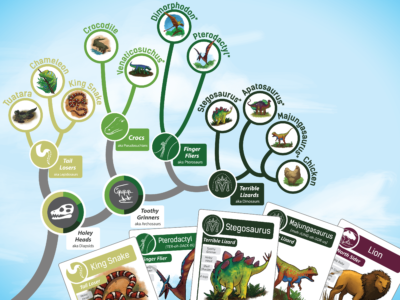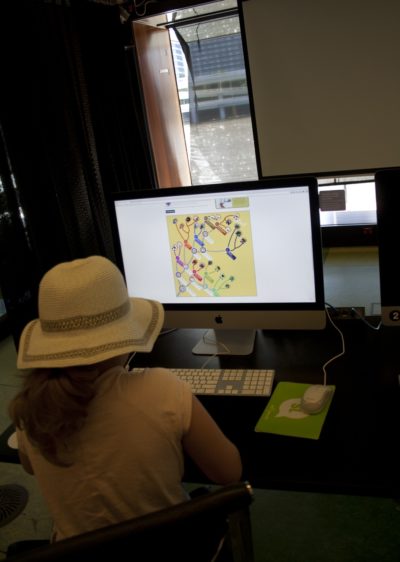Fulbright Scholar and University of Queensland evolutionary biology Ph.D. student, Ariel Marcy and the STEAM Galaxy Studios team merged evolutionary biology and a familiar children’s game together to create Go Extinct! –a table-top game styled after Go Fish! that introduces players to evolutionary trees. Marcy explains that understanding evolutionary trees is central to understanding evolutionary biology and how species, including ourselves, are connected through common ancestors. It is a powerful tool in challenging misconceptions about evolution, humans’ “place” in the world, and the importance of biodiversity. Marcy explains:
At least for me personally, the evolutionary tree illustrates very succinctly how every single creature on Earth has come from a 4-billion-year history. Not only is this astounding in and of itself, but it also reminds us that this 4-billion-year history, with all the unique climates and chance events, will never be repeated again.
The tree can also reveal the features of contingency, time, and “bushiness” that are central to evolution:
Contingency: Contingency means that the survival of species over time is dependent on a variety of outside factors, some of which are random (like beneficial mutations) and some of which are constantly changing (like the climate). Therefore no one species is “destined” to survive. For example, Earth would have a very different set of species living today if the meteor that killed most of the dinosaurs had missed. Many evolutionary biologists, like Stephen J. Gould argue that if the Earth reset and evolution began all over again, life would look completely different than it does today. This is a humbling idea for us humans but also one that highlights the precious, unrepeatable evolutionary history that every species records its perspective on.
Time: One of the hardest things to understand about evolution is the huge amount of time it takes place over. No human mind can really grasp the scale of a million years, let alone 4 billion (roughly the amount of time life has been evolving on Earth). So it can be difficult to appreciate what today’s biodiversity represents in the context of anthropogenic climate change.
“Bushiness”: One of the biggest misconceptions about evolution is that it is a linear, progressive process with an implied end goal that is somehow “better” — like the famous image of a monkey slowly standing up to become a human. In reality, evolution is not directed at all and is better understood as a “bushy” process of one population splitting and branching off, over and over. Over time, two separated populations become different species as random changes occur and as they adapt to different environments (note that one is not “more evolved” than the another because they have been evolving for the same amount of time). In contrast to the linear view of evolution, the “bushier” reality features many lineages branching off.
However, these same aspects of evolution that the tree is so well suited to portraying, can also make it extremely intimidating. There is a reason why the image of a monkey slowly standing up to become a man is a more popular t-shirt design than an evolutionary tree (though there are some beautifully styled ones that perhaps should be considered).

Because the evolutionary tree is such a power tool, Marcy and the STEAM Galaxy Studios team wanted to find a way to make it more approachable, and they turned to games. Paradoxically, they found their inspiration in the same non-linear structure that can make the tree so intimidating. Organized as sets nested within larger sets, they recognized that the evolutionary tree lends itself to the familiar objective for players to “collect them all”.
Go Extinct! consists of species cards and a simplified, yet accurate, evolutionary tree board. As a player, you are trying to collect “sets” or clades of species cards. These sets are designated on the game board by color coding and also with playful, indicative names such as Slimeballs (aka Amphibians). Like in Go Fish! you use your turn to ask a specific opponent for a card that will move you closer to a set. Unlike in Go Fish! you do not have to ask for the exact card. In Go Extinct! you can ask for the exact card or any group on the tree that contains your card. The strategy of the game encourages players to learn how to use the evolutionary tree to find deeper common ancestors between the various species they have in their hand to reveal less information to their opponents.

In a recent development, DIY Go Extinct! now allows you to go one step further in your exploration and actually design your own evolutionary tree and pick your species cards. Through an online platform you choose your tree from six options: Great Barrier Reef, Australian Megafauna, Australian Marsupials, Venomous Snakes, Flowering Plants, and Dinosaurs. You are then prompted to select your species from a curated list, arrange your tree, pick your colors, and finally to make printable PDFs of your cards and board. In additional to allowing more people to access and play Go Extinct! the DIY version provides further opportunities for participants to explore evolutionary trees and illustrates how each branch can be representative of a multitude of species.
The evolutionary tree options were developed to highlight the unique species of more unusual evolutionary trees to spark curiosity and appreciation for biodiversity. For example, the Great Barrier Reef evolutionary tree incorporates every major phylum in the animal kingdom and includes many endemic species –they are found nowhere else. Marcy points out that in doing so, the game “highlights the importance of maintaining ecosystems like the Great Barrier Reef, which are biodiverse and under threat.”
Overall, Go Extinct! and DIY Go Extinct! aim to familiarize people with evolutionary trees as a tool for better understanding biodiversity and our place in the world. Marcy states, “I hope increased comfort with how we stand as equals among other species on the evolutionary tree makes more room for wonder at how much biodiversity exists and a motivation to protect it.” Marcy recognizes that climate change and biodiversity loss can understandably be associated with a lot of fear. Through games, Marcy aims to provide a medium where people can playfully interact with these themes and be inspired instead of numbed by the news:
All in all, I hope Go Extinct! games will provide people with a better understanding of how evolution works as well as an increased familiarity with what biodiversity exists (or existed in the past). Once people have a playfully-conveyed understanding of evolutionary trees, I hope it will scaffold more serious conversations about related concepts regarding climate change and protecting biodiversity.
You are encouraged to visit DIY Go Extinct! to design your own board and cards, and to learn more about Go Extinct! and STEAM Galaxy Studios.
The above post is part of the MAHB’s Arts Community space –an open space for MAHB members to share, discuss, and connect with artwork processes and products pushing for change. Please visit the MAHB Arts Community to share and reflect on how art can promote critical changes in behavior and systems and contact Erika with any questions or suggestions you have regarding the space.
The views and opinions expressed through the MAHB Website are those of the contributing authors and do not necessarily reflect an official position of the MAHB. The MAHB aims to share a range of perspectives and welcomes the discussions that they prompt.
